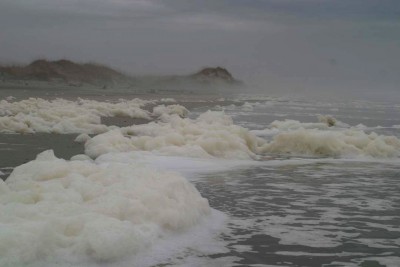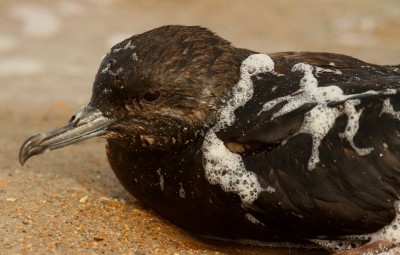
As I jogged along the beach one morning, gusty winds busted apart huge sudsy chunks of sea foam lining the shore, scattering it into softball-size dollops that slid up the sloping, sandy beach. As the foam raced along, the soapy globs looked like gremlins disappearing into the beach as the sand popped the air bubbles in the foam and they shrunk in size. Long lines of the foam stretched down the shore up to 20 feet wide and almost two feet thick in some places.
In one iceberg-looking chunk, I saw something moving within. I scooped and fanned the foam away until the head of a sea bird poked through like a periscope.
Supporter Spotlight
Hurricanes, tropical storms or any period of strong sustained winds will transform the surface of the ocean into a churning agitated chaos of crashing, tumbling and pounding waves. As the energy of these waves surges upon the shoreline it will transport and deposit oceanic flotsam onto the beaches. As the tide recedes, seashells from gastropods and bivalves along with seaweed and driftwood litter the shore.
The eager, beachcombing seashell collectors that are the first to reach the beach after a storm will also notice something else, a thick fluffy white layer of sea foam. Depending on the amount of turmoil that the waves have created, the height and thickness of sea foam on the beach may vary from inches to feet. But the volume of sea foam is also dependent on the ingredients that make it form in the first place. Air, water and decaying organic matter are all players that collaborate to create this frothy formula.
Over the years, I have been approached by people holding out heaping bubbling handfuls of the foam and asked, “What is this?” Well, the foam is created when windy weather aerates the top surface of the ocean. If just air and water are present, air that is trapped under the water in bubbles will normally rise to the surface and pop. Add what is known as a surfactant, such as decaying organic matter containing fats and proteins, the air bubbles tend to stick together. In most cases, the organic matter is decomposing algae, seaweeds and other ocean plants. The surfactant particles are drawn to and resist water at the same time.
When all of these particles are swirling around together, their magnetic-like properties trap air between thin layers of water creating bubbles. The dissolved organic matter also provides a bit of structure, giving the foam strength.
Supporter Spotlight
The stunning display occurred thanks to the raw swell agitating the water, strong southeasterly winds and over six inches of rain washing a large amount of organic material into the turbid waters of Louttit Bay in Australia.
Sea foam has the potential to materialize along any shoreline if the ingredients and weather condition collide at the right time. In some instances, the amount of foam seems unbelievable, covering roads, cars and houses. A 2007 occurrence in Australia earned one beach town the nickname “Cappuccino Coast.”
Typically sea foam occurs naturally and is harmless. However, at times stormwater runoff can reach the ocean containing pollutants that effervesce and could pose a health hazard. Even some naturally occurring algae may have toxins that are irritants to our lungs and skin.

This brings us back to the bird, a sooty shearwater, which I found encased within the sea foam on my morning jog. Not far from that bird, I found an Audubon’s shearwater, also coated in the sea foam. Both birds were docile, weak, soaked and unable to fly. Sea foam produced by some types of algae has been known to reduce the ability of bird feathers to repel water. When the birds come into contact with the foam they become soaked and the feathers are unable to keep them warm and dry, resulting in hypothermia.
I assume that this may have been the case with these two sea birds since they were completely soaked. I scooped up both of the shearwaters and took them to a local wildlife rehabilitation center.
Sea foam can even be quite beautiful in the soft golden light of the setting sun. According to one Greek myth, Aphrodite, the goddess of beauty and love, was created in the sea foam. The word “aphros” is even Greek for foam. She was born from the sea foam after an unfortunate sickle incident involving Uranus, the god of the sky, and his son, Cronus. You’ll have to research the details of this one on your own.







